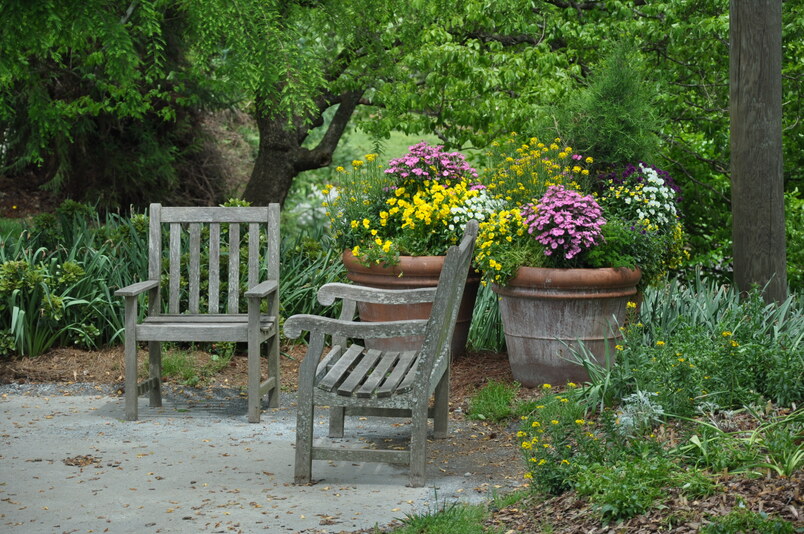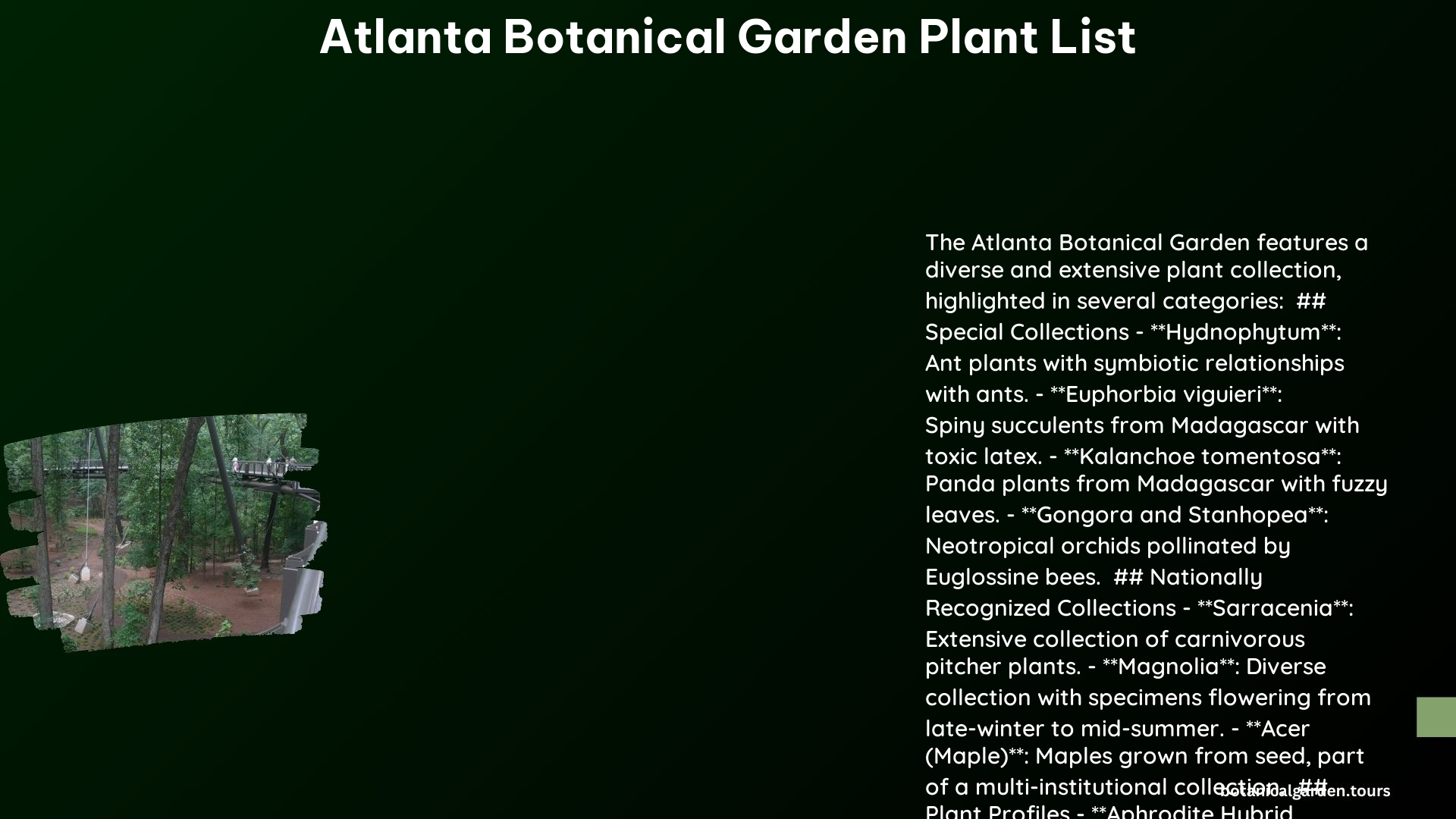The Atlanta Botanical Garden boasts an extensive and diverse plant collection, featuring a wide array of species from trees and shrubs to rare orchids and carnivorous plants. This comprehensive list includes native southeastern species, exotic tropical plants, and endangered flora. The garden’s collection serves both aesthetic and conservation purposes, showcasing the beauty of nature while actively participating in plant preservation efforts.
What Are the Main Plant Categories in the Atlanta Botanical Garden?

The Atlanta Botanical Garden’s plant collection can be broadly categorized into the following groups:
- Trees and Shrubs
- Orchids
- Carnivorous Plants
- Camellias
- Hydrangeas
- Magnolias
- Conifers
- Ferns
- Wildflowers and Herbaceous Plants
What Notable Trees and Shrubs Can Be Found in the Garden?

The garden features an impressive array of trees and shrubs, including:
- Tulip poplars
- Carolina silverbell
- Georgia Oak (Quercus georgiana)
- Florida Torreya
Of particular interest is the Georgia Oak, a rare deciduous red oak species endemic to isolated granite outcrops in the southeastern United States.
Which Orchid Species Are Showcased in the Garden?
The Atlanta Botanical Garden is renowned for its extensive orchid collection, which includes:
- Chapman’s Fringed Orchid (Platanthera chapmanii)
- Dancing Lady Orchid
- White Fringeless Orchid
- Gongora species
- Stanhopea species
- Cigar Orchid
- Cyrtochilum macranthum
- Paphiopedilum victoria-regina
Many of these orchids are part of the garden’s conservation efforts, with species like the Chapman’s Fringed Orchid being propagated in the Micropropagation Lab to safeguard their future.
What Types of Carnivorous Plants Are on Display?
The garden showcases a variety of carnivorous plants, including:
- Sarracenia (Pitcher plants)
- Dionaea (Venus flytrap)
- Drosera (Sundews)
- Pinguicula (Butterworts)
These fascinating plants are adapted to capture and digest insects, making them a popular attraction for visitors.
How Does the Garden Showcase Its Camellia Collection?
The Atlanta Botanical Garden’s camellia collection focuses on:
- Hardy species suitable for the Atlanta area
- Various cultivars that thrive in the local climate
Camellias are known for their beautiful flowers and evergreen foliage, making them a year-round attraction in the garden.
What Varieties of Hydrangeas Can Visitors Expect to See?
The hydrangea collection at the garden includes cultivars of:
- Hydrangea quercifolia (Oakleaf hydrangea)
- Hydrangea macrophylla (Bigleaf hydrangea)
- Hydrangea paniculata (Panicle hydrangea)
- Hydrangea serrata (Mountain hydrangea)
- Hydrangea arborescens (Smooth hydrangea)
These hydrangeas are prominently featured in the Anne Cox Chambers Garden, where they are combined with other native and non-native plantings for aesthetic appeal.
What Makes the Magnolia Collection Special?
The magnolia collection at the Atlanta Botanical Garden focuses on:
- New and late-blooming cultivars
- Asian evergreen magnolias
This collection showcases the diversity within the Magnolia genus and provides visitors with a chance to see both familiar and exotic species.
Which Conifer Species Are Featured in the Garden?
The conifer collection emphasizes:
- Dwarf conifers
- Unusual conifer species
- Cryptomeria japonica cultivars
- Chamaecyparis obtusa cultivars
These conifers add year-round interest and structure to the garden’s landscape.
What Types of Ferns Can Be Found in the Garden?
The fern collection at the Atlanta Botanical Garden includes:
- Species native to the southeastern United States
- Asian fern species
Ferns contribute to the garden’s understory plantings and add texture to shaded areas.
How Does the Garden Showcase Its Wildflower and Herbaceous Plant Collection?
The wildflower and herbaceous plant collection features:
- Daffodils
- Native wildflowers
- Various bulb species
These plants are often used in naturalistic plantings throughout the garden, creating colorful displays in different seasons.
What Rare and Endangered Plants Are Part of the Garden’s Conservation Efforts?
The Atlanta Botanical Garden is actively involved in the conservation of several rare and endangered species, including:
- Georgia Oak (Quercus georgiana)
- Florida Torreya
- Georgia Aster
- Smooth Coneflower
- Small Whorled Pogonia
- White Fringeless Orchid
These conservation efforts involve propagation, habitat restoration, and monitoring of wild populations.
How Is the Anne Cox Chambers Garden Designed?
The Anne Cox Chambers Garden is designed to:
- Showcase a variety of plants in an aesthetically pleasing setting
- Emphasize native plants where horticulturally appropriate
- Combine native and non-native plantings for visual interest
- Provide educational opportunities about horticulture and plant conservation
This garden serves as a centerpiece of the Atlanta Botanical Garden, demonstrating how diverse plant species can be combined in a beautiful and educational display.
The Atlanta Botanical Garden’s plant list is a testament to its commitment to biodiversity, conservation, and horticultural excellence. By maintaining such a diverse collection, the garden not only provides a beautiful space for visitors but also plays a crucial role in plant conservation and education.
References:
1. Plant Profiles – Atlanta Botanical Garden
2. Storza Woods – Atlanta Botanical Garden
3. Atlanta Botanical Garden Plant Collection Policy
